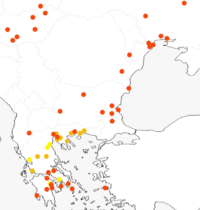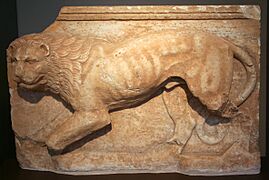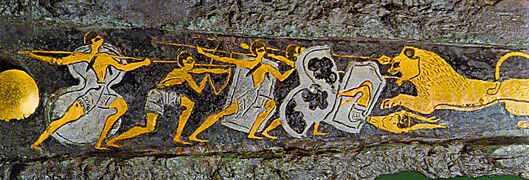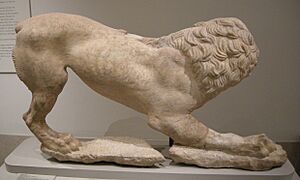History of lions in Europe facts for kids
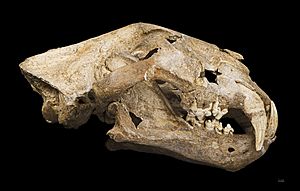
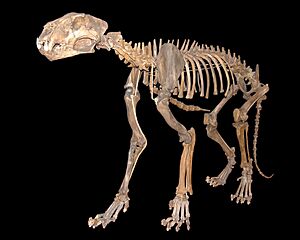
Lions have lived in Europe for a very long time! Scientists know this because they have found many fossils of lions from different time periods. These periods are called the Pleistocene (a time of ice ages) and the Holocene (our current time). People started finding these lion fossils in Europe in the early 1800s.
The first lion fossil was found in southern Germany. A scientist named Georg August Goldfuss described it. He called it Felis spelaea. This lion probably lived between 191,000 and 57,000 years ago, during a cold period called the Würm glaciation.
Even older lion skull pieces were found in Germany. These were described in 1906 and are thought to be between 621,000 and 533,000 years old! These very old lions are sometimes called Panthera leo fossilis.
Modern lions (Panthera leo) also lived in parts of Southern Europe when the Holocene period began. Ancient books, like the Iliad from ancient Greece, even talk about lions.
Contents
What Were These Ancient Lions Like?
Scientists have studied the bones of the ancient spelaea lions. They found that these lions were much bigger than the lions we see today. Their teeth were also a bit different.
Paintings and drawings from ancient times show us what modern lions in the Balkans (a region in Southeast Europe) looked like. These lions had smaller manes (the hair around their necks) compared to lions from other areas. They didn't have much hair on their bellies or legs. However, lions from a region called Transcaucasia (near the Caucasus mountains) had full manes and more hair.
Where Did Lions Live in Europe?
Red dots mean lion bones were found there.
Yellow dots are places from Greek legends.
Lions from the Ice Age (Pleistocene)
The oldest lion fossils found in Europe are about 680,000 years old. These were found in the United Kingdom and belong to a very early type of lion called Panthera fossilis.
Lion fossils have been found in many European countries. These include Spain, Portugal, Italy, Belgium, France, the United Kingdom, Germany, Poland, Czech Republic, Slovakia, Hungary, and Russia.
Later, during the last part of the Ice Age, another type of lion called Panthera spelaea (often called the cave lion) lived across a huge area. Their bones are between 109,000 and 14,000 years old. These cave lions lived from Spain all the way across northern Asia and even into Alaska. In Europe and Asia, they died out about 14,900 to 14,100 years ago. They lasted a little longer in Alaska, until about 13,800 to 13,300 years ago.
Lions from Modern Times (Holocene)
The earliest remains of modern lions from the Holocene period were found in Basque Country, Spain. They are about 11,600–9,000 years old. However, scientists are not completely sure if these were modern lions or if they were some of the last surviving cave lions. Other early modern lion finds in Italy are dated to 12,000-9,000 years old.
A piece of a lion's tooth, about 6,000 years old, was found in Karanovo, Bulgaria. This shows lions were there during the Stone Age. In Greece, lions first appeared around 6,500–6,000 years ago. Bones of modern lions have also been found in Hungary and near the Black Sea in Ukraine. These are about 5,500 to 3,000 years old. Lion remains were also found in Romania and European Turkey.
Where Modern Lions Lived in History
In Southeast Europe, modern lions lived in parts of the Balkan Peninsula, reaching up to Hungary and Ukraine during the Stone Age. They survived in Bulgaria until about 300 or 400 years BCE. Around 1000 BCE, they disappeared from the Peloponnese (a part of Greece).
Lions vanished from Macedonia around the first century CE (Common Era). They were gone from Western Thrace by the 2nd century CE and possibly from Thessaly by the 4th century CE. A writer named Themistius was sad that no more lions could be found for animal shows.
In Transcaucasia, lions were present until the 10th century CE. Their historical range covered plains and foothills, reaching almost to Tbilisi in modern Georgia. They lived north through the eastern Caucasus mountains, all the way to the border of modern Azerbaijan and Russia. Their territory also extended to Yerevan in modern Armenia and westward into Turkey.
Lions in European Culture
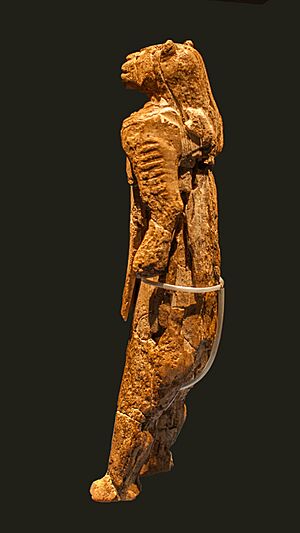
Lions are a big part of ancient Greek mythology and stories. One famous story is about the Nemean lion. This was a huge, powerful lion that was believed to live in the town of Nemea. Homer, a famous Greek poet, mentioned lions 45 times in his poems.
There are many tales about lions in ancient Greece. For example, a ruler named Phalaecus was supposedly killed by a female lion after he took her cub. Another story tells how the city of Olynthus got its name. A young man named Olynthos was killed by a lion during a hunt.
The historian Herodotus wrote that lions lived between two rivers, the Achelous river and the Nestus. He said they were common in certain areas. When the Persian king Xerxes marched his army through Greece in 480 BCE, lions even attacked his troops' camels!
Around 400 BCE, Xenophon wrote that people hunted lions near several mountains in Greece. Aristotle, a famous Greek thinker, wrote about where lions lived, how they behaved, and their bodies. He said lions were more common in North Africa than in Europe. He also mentioned that they usually only attacked people if they were old or had bad teeth.
Pliny the Elder, a Roman writer, believed that European lions were stronger than those from Syria and Africa. In the 2nd century CE, Pausanias wrote about lions living east of the Nestus river in Thrace. He also shared stories about brave people who fought lions, like Polydamas, an Olympic winner who supposedly killed a lion with his bare hands.
The Romans used lions in their shows. They brought Barbary lions from North Africa for lion-baiting (where animals fought). They also used lions from Greece for gladiatorial games, where gladiators fought wild animals.
-
This is a painting of cave lions from the Chauvet Cave in France. It was made by people during the Ice Age!
-
This dagger from Mycenae, Greece, shows a hunting scene with lions. It's from the 16th century BCE.
-
This ancient silver coin from Velia (334-300 BCE) shows the goddess Athena with a helmet decorated with a lion.
-
A stone carving of a lion with colors, found in Bulgaria. It's from the 5th century BCE.
See also
- Panthera leo leo
- Asiatic lion
- Cape lion
- Barbary lion
- Panthera atrox
- Cultural depictions of lions


